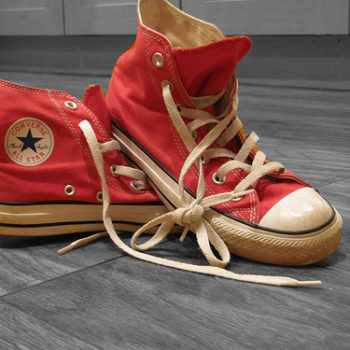The casual outfit that Facebook co-founder and CEO Mark Zuckerberg sported in front of elegantly dressed bankers and investors just before his company went public generated much clamor in the media. While some observers judged the young entrepreneur’s choice to wear his typical hoodie and jeans on such an official occasion as a mark of immaturity, others defended it as a sign of boldness that helped spread publicity about the deal.
Why is the “CEO Casual” look sported by Zuckerberg, Apple CEO Steve Jobs, and certain other business leaders interpreted as a sign of status, while other professionals in casual dress would be laughed out of a job interview?(a) Our research explores the conditions under which nonconforming behaviors, such as wearing red sneakers in a professional setting or entering a luxury boutique wearing gym clothes, lead to attributions of enhanced status and competence rather than social disapproval.
In both professional and social settings, we often make significant efforts to learn and adhere to dress codes, etiquette rules, and other written and unwritten codes of behavior.1 Adherence to such rules and social norms is driven by a desire to gain social acceptance and status and avoid negative sanctions such as social disapproval, ridicule, and exclusion. At times, individuals who are aware of social norms and expectations may nonetheless decide to risk deviating from standards of appropriate dress, speech, and behavior. High-status individuals like Zuckerberg typically have wider latitude for deviation and are relatively freer from social constraints.
To better understand nonconformity, our research examines how third-party observers interpret violations of convention and make inferences about the status and competence of nonconformers.2 Our studies explore various social environments and populations, including shop assistants at high-end boutiques in Milan, Italy, business leaders in an executive education course, and country club members at a black-tie party. In one of our experiments, Dr. Gino taught an executive education class at Harvard Business School wearing red sneakers, which are quite atypical for this environment. We refer to the red sneakers effect to signify the potential benefits of nonconformity.
We find that, in certain cases, nonconforming behaviors can lead to inferences of enhanced status and competence in the eyes of others, and that this is because of – not in spite of – these behaviors’ deviance from the norm. Engaging in behaviors that present the risk of losing status gives off the impression that someone has plenty of status to spare. The dynamics of status signaling through nonconformity are similar to – though possibly more subtle and sophisticated than – the dynamics of signaling through expensive consumer goods. Wealthy individuals signal their position by giving up financial resources to purchase expensive luxury items.(b) Similarly, by giving up the social benefits conferred by conformity, individuals show that they do not need these benefits because they already possess high status.
Clearly, nonconformity is only interpreted in a positive light in certain scenarios; in most situations, deviation from the norm results in disapproval and punishment rather than increased status. Our research illuminates some of the characteristics of the observers, the environment, and the behaviors that need to be in place for nonconformity to fuel positive perceptions of status and competence. We find that the observers’ familiarity with the environment, their perception of the behavior as intentional, and their own history of nonconformity all increase their willingness to assign positive attributes to an individual deviating from established norms.
First, the observer must be somewhat familiar with the environment. Only observers who are acquainted with the consumption context and have experience observing and interpreting behavior in this specific context will derive positive inferences from signals of nonconformity rather than conformity. For example, in one of our studies, shop assistants at luxury boutiques in Milan, Italy considered a shopper more likely to make a purchase or be a celebrity when she was wearing gym clothes or a Swatch watch than when she was wearing an elegant dress or a Rolex. In contrast, pedestrians recruited at Milan’s central train station – of a similar demographic and socioeconomic background but less familiar with the luxury boutique environment – tended to perceive the elegantly outfitted shopper as possessing status greater than or equal to the poorly dressed shopper. Since they are more familiar with the context, the shop assistants are capable of finer, more articulated discrimination in that specific environment and rely less on prototypical product symbols to discern status.
Second, the environment must be one with clearly established norms that the individual intentionally defies. For example, wearing gym clothes is a noticeable aberration in a luxury boutique with an expectation of nice attire, but not in a discount store where casual dress is the norm. Observers must believe the nonconforming individual is both aware of the norm and able to conform to it, but deliberately decides not to.(c)A nonconforming behavior that seems unintentional or dictated by lack of a better alternative – such as ragged clothes on a homeless person – will not lead to a positive impression.This perception that the individual is consciously choosing not to conform is critical because, in order to signal status, deviations must demonstrate the autonomy to act according to one’s own inclinations and to bear the cost of nonconformity. In another study, we found that participants perceive a guest wearing a red bow tie at a black-tie country club party as a higher-status member of the club and as a better golf player than a conforming individual wearing a black bow tie. This assumption is based on the belief that the red bow tie wearer has enough status and autonomy to follow his preferences, even when they deviate from the norm.(d)
Lastly, we found that observers who value uniqueness and habitually engage in atypical choices themselves, such as owning unconventional consumer products, are more sensitive to nonconforming behaviors and assign them more status. For example, in one of our studies, business executives who owned an unusual pair of shoes attributed higher status and competence to a professor teaching a class at Harvard wearing a pair of red Converse sneakers than did observers with more mainstream taste in shoes. Furthermore, respondents who reported a greater general need to feel unique were more likely to approve of this professor’s choice, suggesting that the effect extends beyond cases where the observer’s unusual consumption choices are identical to those being observed.
Should we all pack up our elegant shoes and start wearing bright red sneakers to work? Increasing our status in the eyes of others is clearly an important goal, as it can grant us power and influence within our social groups and organizations. Weighing the benefits of adherence to social norms against the potential, more risky upsides of nonconforming practices is a difficult judgment call. Readers should consider whom they are aiming to impress and whether they are confident enough to withstand some occasional odd looks (which, we can assure, you will get!).(e) Adherence to social norms – in other words, leaving the red sneakers at home – might be a wiser strategy for some people, but if you can forgo the benefits of conformity and tolerate the potential costs of nonconformity if things go sour, marching to the beat of a different drummer can have some surprising upsides.
Endnotes
- While conformity is rewarded with group acceptance and social inclusion, nonconformity can be risky and costly, often leading to social disapproval, rejection, and punishment. For resarch on the advantages of conformity, see: Robert B. Cialdini and Noah J. Goldstein (2004) “Social Influence: Compliance and Conformity,” Annual Review of Psychology, 55(1974): 591-621. On the risks of nonconformity, see: Cameron Anderson, Daniel R. Ames, and Samuel D. Gosling (2008) “Punishing Hubris: the Perils of Overestimating One’s Status in a Group,” Personality and Social Psychology Bulletin, 34(1): 90-101. The power of these rewards and sanctions has been demonstrated in classic social psychology experiments, such as: Solomon E. Asch (1956) “Studies of Independence and Conformity: A Minority of One Against a Unanimous Majority,” Psychological Monographs: General and Applied, 9(70): 1-70; Richard S. Crutchfield (1955) “Conformity and Character,” American Psychologist, 10(5); and Stanley Milgram (1963) “Behavioral Study of Obedience,” Journal of Abnormal and Social Psychology, 67(4): 371-378.
- Silvia Bellezza, Francesca Gino, and Anat Keinan (forthcoming) “The Red Sneakers Effect: Inferring Status and Competence from Signals of Nonconformity,” Journal of Consumer Research, Vol. 41.
Sidenotes
- (a) The Wall Street Journal described the “CEO Casual” look in 2008 as a trend created by a generation of technology entrepreneurs, such as Apple CEO Steve Jobs, wearing jeans, sweatshirts, and other informal clothes in professional settings. The style is sometimes attributed to business leaders aiming to appear relatable to their employees and clients, while in other cases it is suggested to reflect a lack of interest in style and fashion.
- (b) Ostentatious displays of wealth meant to convey prestige, known as conspicuous consumption, have been compared to the handicap principle in evolutionary biology. This principle describes situations in which a species evolves to seek out mates with seemingly disadvantageous traits because the survival of these animals indicates they are fit enough to deal with the burden of the traits. For example, a peacock’s tail poses evolutionary disadvantages – it is heavy to drag around – but the ability to carry around a heavy tail demonstrates the bird’s strength. Similarly, living with the “handicap” of spending money on luxury items with little practical use signals that an individual is wealthy enough not to suffer from this loss.
- (c) When Julia Roberts’s character in Pretty Woman goes shopping in Beverly Hills, store clerks snub her for her unsophisticated style. This is likely because the character’s informal clothing choices are due to a lack of options, rather than a willful choice to stand out.
- (d) Recent articles in the British and American press have compared the formal, upscale fashion choices of Kate Middleton, the wife of Prince William, with the relaxed, bohemian look favored by Cressida Bonas, Prince Harry’s current girlfriend. Some have attributed this difference in style to the women’s class backgrounds, suggesting that Middleton’s middle-class upbringing leaves her with something to prove, while the aristocratic Bonas can choose not to care about how her fashion choices are perceived.
- (e) While Dr. Gino, a tenured professor at Harvard Business School, happily volunteered to test our hypotheses by teaching a class to business executives wearing red sneakers, Ms. Bellezza, a doctoral student, would never dare engage in such conduct.






